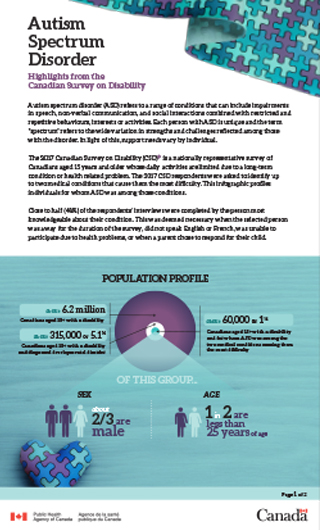Infographic: Autism Spectrum Disorder - Highlights from the Canadian Survey on Disability

Download the alternative format
(PDF format, 898 KB, 1 page)
Organization: Public Health Agency of Canada
Date published: March 2020
Autism spectrum disorder (ASD) refers to a range of conditions that can include impairments in speech, non-verbal communication, and social interactions combined with restricted and repetitive behaviours, interests or activities. Each person with ASD is unique and the term “spectrum” refers to the wide variation in strengths and challenges reflected among those with the disorder. In light of this, support needs vary by individual.
The 2017 Canadian Survey on Disability (CSD)Footnote 1 is a nationally representative survey of Canadians aged 15 years and older whose daily activities are limited due to a long-term condition or health related problem. The 2017 CSD respondents were asked to identify up to two medical conditions that cause them the most difficulty. This infographic profiles individuals for whom ASD was among those conditions.
Close to half (48%) of the respondents’ interviews were completed by the person most knowledgeable about their condition. This was deemed necessary when the selected person was away for the duration of the survey, did not speak English or French, was unable to participate due to health problems, or when a parent chose to respond for their child.
Population Profile
- about 6.2 million Canadians aged 15+ with a disability
- about 315,500 or 5.1% of Canadians aged 15+ are living with a disability and diagnosed developmental disorder
- about 60,000 or 1% of Canadians aged 15+ are living with a disability and ASD being among the two medical conditions causing them the most difficulty
- Of this group:
- About 2/3 are male
- 1 in 2 are less than 25 years of age
- Of this group:
Of Canadians aged 15+ with a disability and for whom ASD was among the two medical conditions causing them the most difficulty:
General health
31% describe their general health as “excellent” or “very good”, compared to 61% of the Canadian household population aged 15 years and older.Footnote 2
Mental health
16% describe their mental health as “excellent” or “very good”, compared to 70% of the Canadian household population aged 15 years and older.Footnote 2
Severity
55% report having “severe” or “very severe” disability, compared to 43% of those with any type of disability.
Co-occurring disabilities
87% report a co-occurring disability with learning being the most common (72%) followed by mental health-related (55%).
Support
74% report receiving help with at least one type of everyday activity, with the most common being:
- help looking after personal finances (61%)
- getting to appointments/running errands (61%)
- preparing meals (53%)
Aids or assistive devices
53% report using at least one aid or assistive device with cognitive aids being used the most, specifically:
- computer with specialized software (30%)
- speech-text/voice recognition software (21%)
- audio book or e-book device (18%)
Education (aged 20+ years)
35%Footnote 3 report having less than high school education, compared to 12% without disability.
Employment (aged 20 – 64 years)
33%Footnote 3 report being employed, compared to 79% without disability.
Sources of Income (aged 20 – 64 years)
- 14%Footnote 3 employmentFootnote 4 only
- 54% non-employmentFootnote 5 only
- 29%Footnote 3 both employment and non-employment
- 3%Footnote 3 no income
To learn more about autism spectrum disorder in Canada, visit Canada.ca and search “autism” or “ASD”. Follow us on social media: Facebook - @HealthyCdns Twitter - @GovCanHealth
- Footnote 1
-
Canadian Survey on Disability, 2017. At: https://www23.statcan.gc.ca/imdb/p2SV.pl?Function=getSurvey&SDDS=3251
- Footnote 2
-
Canadian Community Health Survey: Annual Component, 2017. At: https://www23.statcan.gc.ca/imdb/p2SV.pl?Function=getSurvey&Id=329241
- Footnote 3
-
Estimates should be interpreted with caution due to high sampling variability.
- Footnote 4
-
Employment income sources include wages, salaries, tips, commissions or gratuities.
- Footnote 5
-
Non-employment income sources include workers' compensation, pensions and annuities, employment insurance, provincial or municipal social assistance or welfare, Old Age Security and Guaranteed Income Supplement, investment income, spousal support, child support, scholarships, child tax credit, Northern allowance, etc.